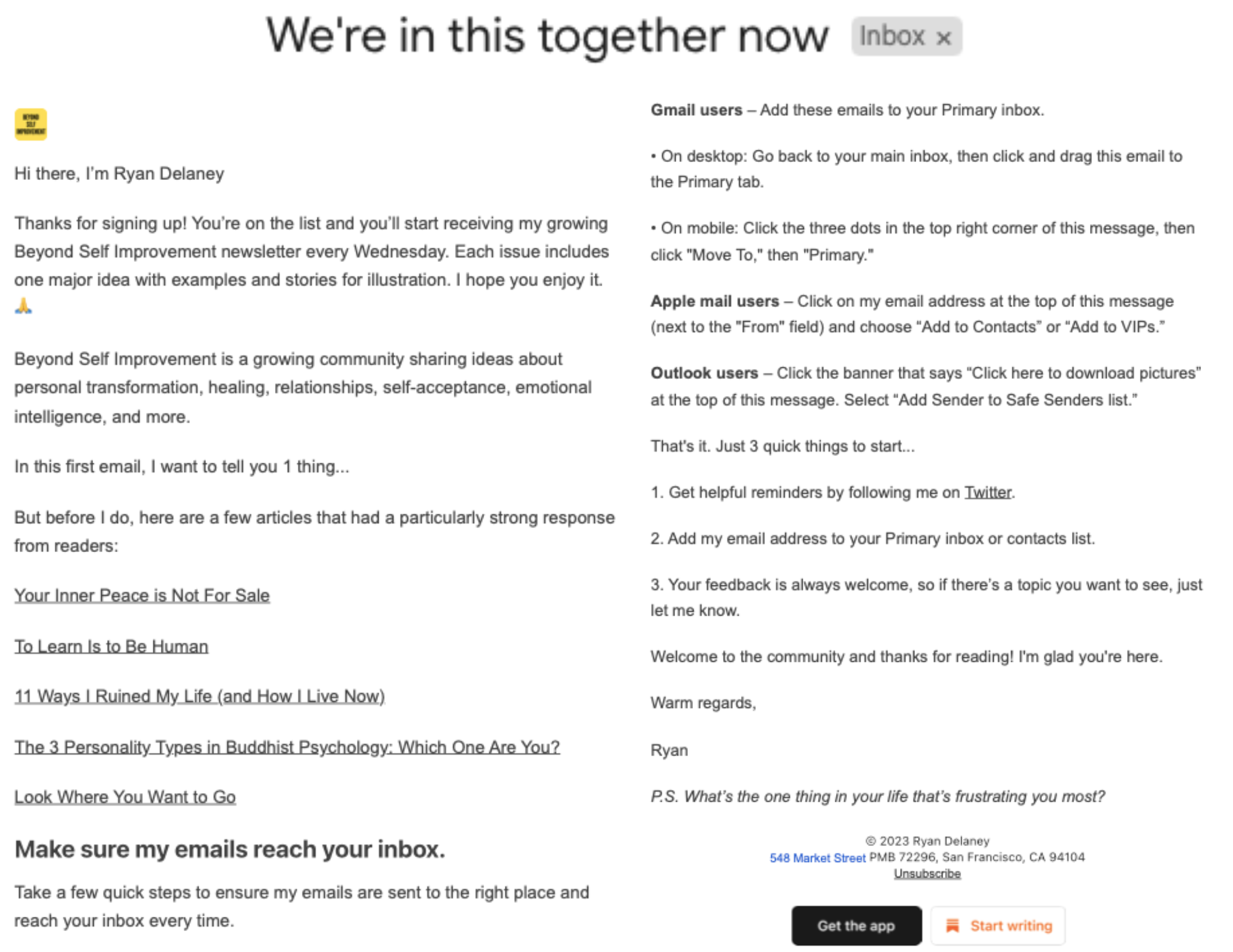Welcome Email Breakdowns
A well-crafted welcome email sets the tone for a subscriber’s journey. It’s the first impression and a valuable opportunity to engage, build trust, and encourage action. Below, I analyzed two different welcome emails, highlighting their strengths, areas for improvement, and overall effectiveness.
#1: Extra Focus
What key elements make this welcome email engaging?
Subject Line: A typical but effective approach, with the addition of an ADHD strategy guide—a thoughtful touch that adds value.
Font & Formatting: Uses a standard font with bolded and italicized words for emphasis. Headings and section breaks make it easy to scan.
Tone: Friendly and inviting; the phrase “hey friend” establishes a warm, conversational atmosphere.
Word Choice: The phrase “can you do me a quick favor” is a smart way to lead into a call to action (CTA), making it feel natural.
Headlines: “Free ADHD strategy guide” signals a helpful, value-driven approach, giving subscribers a useful resource right away.
Images & Emojis: No images, but well-placed emojis make the email feel more personal and engaging.
Q&A Breakdown
Is this email good?
Yes! The email includes:
A friendly introduction
Expectation setting
Reciprocity (“Can you do me a quick favor?”)
A clear and engaging CTA
A personal signature
The addition of a free resource—the ADHD strategy guide—demonstrates a willingness to help subscribers understand and manage ADHD.
Is it bad?
Not at all. However, a brief personal introduction or a photo of the sender could further establish a connection with the audience.
Is it effective?
Yes! It was engaging enough to prompt a response, even if it was just sharing a favorite emoji (😆). The ADHD strategy guide is a strong touch, aligning well with the content’s theme.
Does it have a call to action?
Yes! The CTA—“Hit reply and send an email with your favorite emoji”—is simple, engaging, and encourages direct interaction.
Does it create excitement for future emails?
Absolutely! The bullet points hint at exclusive benefits for paid subscribers, generating curiosity.
General impression of the content creator/company?
The heavy use of emojis suggests a fun, approachable personality. The email feels warm and engaging, setting a positive first impression.
What could be improved?
A personal introduction would help establish a stronger connection with subscribers.
#2: Beyond Self Improvement
What key elements make this welcome email engaging?
Subject Line: Personable and welcoming, making subscribers feel like part of something meaningful.
Font & Formatting: Uses bolded and underlined text to highlight key points. Well-spaced paragraphs make it easy to read.
Tone: Friendly and professional—less casual than the previous email but still engaging.
Word Choice: More formal, but clear and accessible.
Headlines: “Make sure my emails reach your inbox”—a practical, if straightforward, approach to ensuring deliverability.
Links & CTAs: Includes links to content and a P.S. section, both encouraging interaction.
Q&A Breakdown
Is this email good?
Yes! Like the first email, it follows key elements:
Engaging subject line
Linked content for further exploration
Two CTAs
A personal signature
A P.S. section, reinforcing engagement
The inclusion of links allows subscribers to dive deeper into the content right away.
Is it bad?
No, but like the first email, it could benefit from a more personal touch—perhaps a brief introduction from the sender.
Is it effective?
Yes! The linked content and interactive closing question make it engaging. Subscribers are encouraged to reflect on their own challenges and explore solutions within the provided content.
Does it have a call to action?
Yes! The primary CTA—“What’s the one thing in your life that’s frustrating you most?”—invites introspection and encourages engagement with the content.
Does it create excitement for future emails?
Yes! The promise of transformation through engaging content builds anticipation.
General impression of the content creator/company?
Professional and insightful. The structured format and clear guidance give the impression of valuable, well-thought-out content.
What could be improved?
A bit more personality would enhance connection. A short introduction to the sender would help subscribers feel more engaged.
In conclusion…
Both emails are effective in different ways:
Extra Focus excels in warmth and engagement, making subscribers feel instantly welcomed.
Beyond Self Improvement is more structured and professional, providing clear direction and valuable resources.
A strong welcome email not only sets expectations but also builds relationships. Whether through warmth, professionalism, or engaging CTAs, these elements make a significant impact on subscriber retention and engagement.

